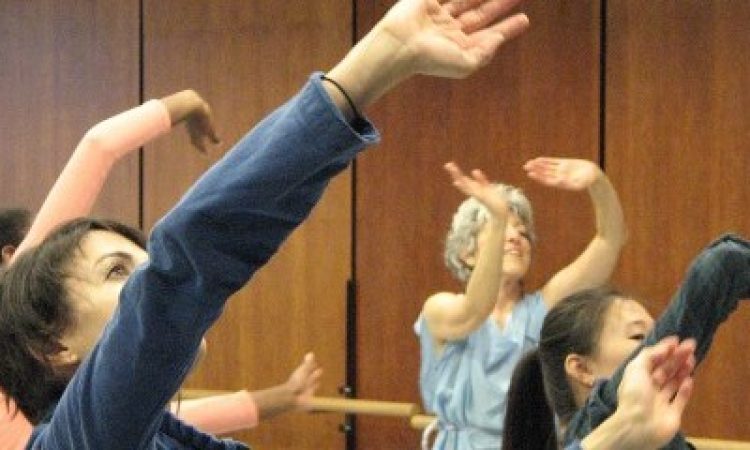Too many master classes focus on the first noun, evoking images of a brutal teacher reducing timid students to tears for failing to achieve unattainable aesthetic ideals. Both serious and comedic works (by Terrence McNally and Saturday Night Live, among others)—not to mention the real-life personalities on which these plays and skits draw—have helped reinforce this common conception.
However, the master class held by the Isadora Duncan Dance Foundation at Drexel University on October 7, 2011, emphasized the classroom. Here, scholar and former Isadora Duncan Dance Company* member Alice Bloch led students through a 90-minute session that blended history, anatomy, gender and sexual politics, and identity, with the sociology of dance and Duncan’s choreography in a way that presented Duncan’s technique as an undemanding, integrated, philosophical approach to movement.
As about 30 students from Eastern University, Swarthmore College, Bryn Mawr College and Drexel University sat on the floor in leggings, gym shorts and the occasional unitard, Bloch showed a series of slides. Some depicted Duncan in a few of her now-classical poses—her torso tilted at the waist and arms outstretched in a gesture of receiving—others displayed the Greek and Roman statues and other artworks that influenced Duncan’s choreography.
Bloch blended bold claims—“Duncan was the Lady Gaga of her time”—with historical explanations about gender, culture and the role of dance in Duncan’s day. She contrasted Duncan’s fame and public bisexuality to an age of strict morals that held dancers and dancing in very low regard. According to Bloch, Duncan spent her life not only reversing that trend, but also challenging ideas about gender, sexuality and art in her successful quest to re-establish dance as one of the central elements of American and world high culture.
Duncan as a kinesthetic genius
While her contemporaries wore constricting corsets, Duncan connected to Greek and Roman art by dancing bare-armed and bare-legged in a tunic (which Bloch also wore). Where classical ballet locked the body into rigid poses and formal, artificial steps, Duncan drew her technique from the way ancient sculptures revealed gravity’s effects on human action, arguing that “even the weight of a costume’s fabric should affect the movement of the body.” Her work tied this inspiration to gymnastics, Pilates and natural activities such as walking, running and falling.
This instructional approach underscored the foundation’s mission to “extending the dream, dance legacy, and indomitable spirit of Isadora Duncan.” After lecturing for 45 minutes, Bloch demonstrated how Duncan put these revolutionary ideas into practice through her art. The students rose from the floor and faced away from the mirrors as Bloch led them through simple breathing exercises that trained them to focus on feeling the solar plexus as the center of the body “from which all natural movement flows.”
The 30 young dancers (all women) imitated Bloch’s poses, raising their arms in a gesture of offering and then pulling them back down to the hips in a gesture of receiving. Following Bloch’s instructions, each dancer performed simple motions, letting gravity draw an arm downward across the body and bend the knees into a plie. They lifted their toes by moving from the solar plexus and through the torso. When falling laterally into a run, Bloch instructed them to “feel the weight of the upper skeleton as it crashes down in the rising tide” that springs from the body’s core.
Bloch glided among the rows of students, giving gentle cues of correction (“relax the shoulders, let them fall on your back”). She remained insistent on the technique while also asking them to “go inside themselves.” Schubert’s String Quartet No. 3 played in the background and a serene, almost contemplative mood erased any tension.
In a post-class question and answer session, Bloch tied her suggestion to “go inside” to Duncan’s role in establishing the philosophical approach of modern dance choreographers. She explained that Duncan originated the idea of a choreographer going into the studio and making her own statement about art. Duncan’s approach treated movement and dancing as aesthetic philosophy; as Bloch elaborated, in “going into yourself but searching for a larger connection, it’s there that you bring beauty and knowledge into the world.”
Drexel dance minor Nina Melissi participated in the class and connected to this idea by commenting that she felt “beyond inspired” and adding that through Duncan technique she learned how to “focus on myself and how the movement happens inside instead of following a choreographer’s steps and style.” Ilana Haas, a dance major at Drexel, had studied ballet for most of her life and never heard of Duncan until the night before the master class. But in Duncan, she “finally discovered a form of dance that lets me find who I am as a dancer.”
Both reflected on the generosity and communal, non-competitive nature of the technique itself. Their comments amplified Bloch’s own admission of her early career frustration with the contemporary post-modern scene in the 1970s. As Bloch stated, after years of performing and seeing oft-confusing works, she felt that—in the work of a choreographer dead 50 years—she was finally “seeing dance as it was meant to be.”
*The Isadora Duncan Dance Company, headed by third-generation Duncan dancer Lori Bellilove, is considered the pre-eminent company performing Duncan’s works today.






